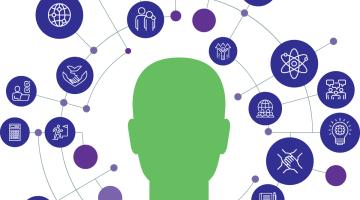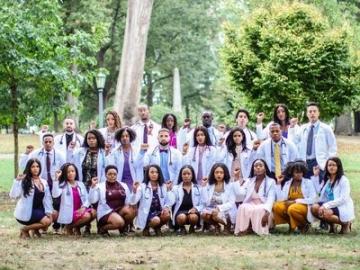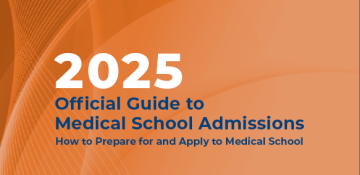New section
"Lean on your strengths. Everyone has weaknesses, insecurities, and flaws that they need to work on. Don't let this intimidating process distract you from the fact that you are capable [of] achieving your dreams of becoming physician."
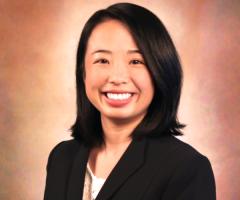
Med School: Western Michigan University Homer Stryker MD School of Medicine, 2019
Undergrad: Tufts University, Biology, 2014
Editor’s Note: The opinions expressed in this article are those of the author and do not necessarily reflect the opinions, positions, or the polices of the AAMC or its members.
New section
Background
- Eldest of three children in an Asian American household.
- Father is a physician.
- Shadowed hematologist/oncologist during junior year of college.
- Taught English as a volunteer in Ho Chi Minh City, Vietnam.
- Pursued humanities, languages, and arts in addition to science coursework.
MCAT® Score/GPA/Coursework
Ai began meeting with her premedical advisor at Tufts University during her freshman and sophomore years while she was still deciding whether or not to apply to medical school, and once she confirmed her decision, she continued to meet with her at least once every semester. Ai said that her advisor, Carol Baffi-Dugan, Advising Dean at Tufts University, counseled her on which premed courses she should take, “but also helped me fit my non-STEM and extracurricular interests into my time at Tufts. I also had a major advisor who was a biology professor. We met once per semester to discuss how my studies and my life were going in general.”
Her prehealth advisor appreciated that Ai made it a point to stop in periodically to ask questions and chat about her decisions and experiences. In getting to know her, Ms. Baffi-Dugan noted a few advantages that were in Ai’s favor as an applicant. First, her father was a physician, so she had early exposure to the profession. Secondly, being from a multicultural family and having experienced living in both Japan and the United States provided Ai with a level of curiosity and open-mindedness as she was comfortable moving between different cultures and languages.
On her application, however, Ai was less confident about some of her metrics including her BCPM GPA and MCAT® score. She said, “I felt a little overwhelmed by the large class sizes often seen in college introductory science courses, and my grades faltered initially. I did better as the years went on, and I was able to succeed in upper-level science courses with smaller classes where I didn’t feel too intimidated to ask for help.” Ai noted that her overall GPA was slightly higher than her school’s average, and her MCAT score was the same as her medical school’s average; however, her BCPM GPA was lower than what she would have ideally liked. As her advisor said, “Ai’s metrics were a little lower than average — not weak, but not spectacular. We had to emphasize the breath of her interests, and the upward trend in her grades. We had to convey her many other strengths and emphasize that her work ethic, motivation, and enthusiasm would lead to her success in medicine.”
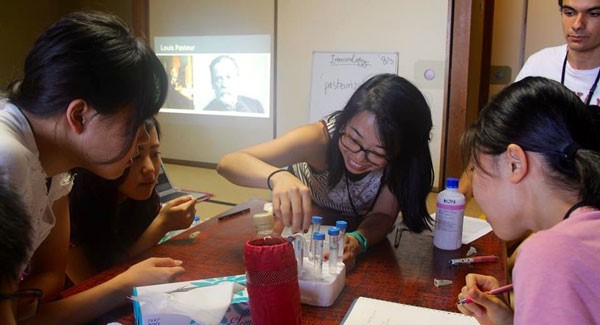
There were many strong aspects of her application, too. Beyond her standard premed courses, and in addition to already speaking Japanese and English, Ai also took Mandarin. In addition, she enriched her education and honed her interpersonal skills through tutoring, volunteer work, a job on campus, and by engaging in research. Jean Shelton, Assistant Dean for Admissions and Student Life at Western Michigan University Homer Stryker M.D. School of Medicine, noted, “as a school without prerequisite courses, we do look for upper-level hard sciences. Ai had taken Cell Biology, Anatomy, Physiology, and Biochemistry which showed us that she had selected and handled a rigorous curriculum. In addition, we saw courses like Ballet, Ancient Medicine in the history department, and Drawing/Painting. This showed a diverse set of interests which is indicative [of] a well-rounded student who will relate to a wide variety of patients.”
Ai was very interested in returning to her home state to pursue her medical education. When completing her applications, her prehealth advisor encouraged her to be sure this was conveyed in her information and to personalize her secondary application so she could impress upon the admissions committee why she felt the school was a good fit.
Experiences
As the eldest of three children in an Asian American household with a father who is a physician, many of Ai’s peers assumed she would follow in her father’s footsteps and pursue medical school, but she kept an open mind through high school and the start of college. “One of the biggest qualms I had about going to medical school was the fact that I have always loved receiving a well-rounded education and had many hobbies. Even in college when I was presented with a choice, I wanted to include the humanities, languages, and arts in addition to the sciences in my coursework. The thought of giving up my other academic interests and hobbies saddened me, but fortunately, I found that I didn’t need to give up my love of these activities to be successful in medical school. In fact, it made me a stronger applicant and medical student.”
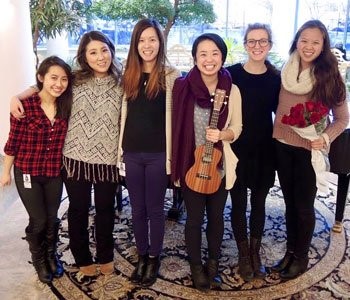
But in Ai’s junior year of college, she had the opportunity to shadow a hematologist/oncologist who changed her perspective. Ai noted, “Not only was he incredibly compassionate and personable, he had a passion for painting and was able to maintain it throughout his career. Seeing him continue his own well-rounded education as a physician inspired me to do the same.”
The Work and Activities section of Ai’s application is where she felt the most confidence. Reviewing that section and seeing the depth and breadth of it all made Ai realize how much she had experienced — the connections she had made, the risks she had taken, and the new perspectives she had gained. She felt that her passion for service and open-minded personality really shone through. Ai said, “I think my studies in Chinese, as well as teaching and volunteering in Vietnam and Japan as a bilingual and bicultural Japanese American, showed an openness to understanding others, cultural competency, ability to work in a team, and commitment to service.” And, according to her prehealth advisor, what made Ai stand out the most in her opinion, was “her sincere enthusiasm for the work she was doing. Rather than seeking to check off the appropriate ‘premed boxes,’ Ai pursued a variety of interests both in the classroom and without, all contributing to her becoming a knowledgeable, compassionate, and culturally competent applicant.”
When evaluating her experiences, the admissions committee at Western Michigan University Homer Stryker M.D. School of Medicine used an online assessment that is part of their supplemental application as well as a phone interview (required before campus interview invitations). “Both of these tools focus solely on personal attributes. The admissions team uses these results in combination with experiences and academic metrics to help find students that have attributes in line with our mission. Ai stood out as an applicant who had strong personal attributes and was aligned with WMed.” One thing Ms. Shelton remembers is that Ai didn’t just state that she was well-rounded, she showed it with her experiences. She demonstrated a substantial liberal arts education, was a ballroom dancer, and an artist. “She was able to draw on these experiences and use their diversity to highlight the type of medical student she would become. The supplemental application showed she had done research on our program drawing correlations to small class sizes and our decompressed curriculum.”
Personal Statement
Ai believed that her application demonstrated that she was hardworking and detail-oriented, able to adapt well to new environments, and enjoyed working with people, particularly with regard to mentoring and teaching young people. In her personal statement, Ai chose to write about the physician from question 3 (regarding her most memorable moment) because it was a turning point in her decision to pursue a career in medicine. Ai said, “I recall a distinct patient encounter that this hematologist/oncologist had while I was shadowing him. When we walked into the patient room, his patient was visibly in pain lying on the exam table. After having a focused conversation regarding their symptoms, the patient turned to regard the painting hung on the wall. They smiled and mentioned that this was their favorite painting of his. They proceeded to have a long conversation about his technique and inspiration for his paintings. The patient was in great spirits by the time we left the room. I thought this was an amazing example of how medicine is not solely about the diagnosis, the lab results, or the medications. Healing can come in many different forms.” Ai asked her peers, friends, and family to help her review and edit her personal statement before submitting it.
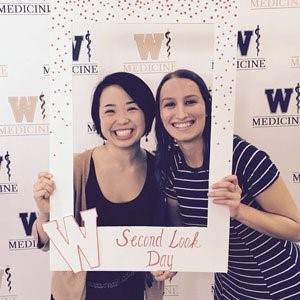
In hindsight, Ai thinks she could have framed some of her experiences differently, though. As she explained, “I put a strong emphasis on how I felt during those situations and did not focus as much on what I could do about it going forward. The lack of concrete career goals may have been simply that it was too soon for me to know, but I feel that I could have thought a little harder about what I wanted to accomplish or how I wanted to impact the medical community.”
Letters of Evaluation
Ai had a close relationship with several of her professors at Tufts (both inside and outside of the biology department), so it was a natural choice to ask them for letters. Additionally, she asked her laboratory Principle Investigator (PI) for a letter, and also requested a composite letter from the Tufts Health Professions Recommendations Committee in addition to her individual letters of recommendation. (Check the MSAR® guide for school policies on which types of letters are accepted and preferred.)
For her individual letter writers, Ai provided them with her transcript and CV. For the composite letter, she wrote a short autobiography and sat for an interview in addition to providing her transcript and CV. Ai said, “I waived my right to see my letters of recommendation, but I imagine that they noted that I am a diligent student and overall, a personable, sincere person.” This sentiment was echoed by her prehealth advisor who said, “I can’t overemphasize how Ai’s positive, enthusiastic, can-do attitude permeated all she did and really made an impression on faculty, employers, and staff. This motivation and willingness to work hard to reach her goals made Ai successful, and a pleasure to work with.”
Interview
Regarding the interview, Ai said she felt confident about how she would perform during the interview process, regardless of whether it was over the phone or in person. She found that she had a much easier time expressing herself in person than on paper, and her admissions team agreed. Ms. Shelton said, “Ai’s interview — both the phone interview and campus interview — showed us her personality. Her application and academics clearly indicated she could handle our curriculum. Her interview showed us that she stood out and would be a valuable member of our community.”
To prepare for her interview, Ai asked her premedical advisor about what to expect. Ms. Baffi-Dugan provided Ai with some information and directed her to resources including those found on the AAMC website. Ai said, “I watched videos online about different interview types such as MMIs and standardized patient cases. Eventually, I attended a mock interview session to practice for the interview.”
According to Jean Shelton, Ai’s interview took place on a day when the university was expecting a lot of snow. “For the first time in recent history, WMed closed the school and associated clinics due to inclement weather. However, the interview day had to go on since many applicants had already braved the weather and made it to Kalamazoo.” What stood out about Ai, according to Ms. Shelton, “was her easygoing demeanor and ability to be flexible with the unknown situation. The chaos of the day easily could have become a distraction, and she didn’t allow that to affect her day on campus.”
During Ai’s one-on-one interview, she spoke with a faculty member about how crucial it is to teach as a physician, especially to patients and families, but also to peers and physicians-in-training. She shared her goals about a career involving medical education. “I believe that my social skills and ability to communicate came across clearly in my interview.” Ai suspects that her BCPM GPA may have been one of the factors that prevented her from getting more interviews or acceptances; however, she doesn’t remember being specifically asked about this in the interview process.
Waitlist
Ai was a student placed on the waitlist at WMed. According to Ms. Shelton, “We knew we liked this applicant, but we have a very small class size (60) and have to make very fine distinctions.” Ai believes her application made it through the initial round of review, logistically, because of the timely submission of her application, as well as the fact that she was a Michigan state resident. Further, she said, “perhaps my personal statement and experiences section also helped me to stand out in the crowd. I think the diversity of my experiences and well-rounded transcript supported the way I presented myself in my personal statement and on interview day. My interests in art in particular may have been unique in the medical school applicant pool.”
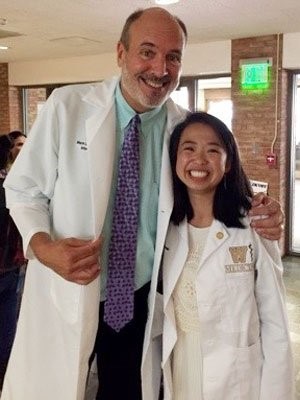
According to Ai, being on the waitlist for several months was very difficult. During that time, she reached out to the school with a letter of intent, stating her interest in the program and intent to matriculate there if accepted. In addition to that, Ai’s prehealth advisor, Carol Baffi-Dugan, followed up with the admissions team. Her admissions team was able to use the additional information and strong endorsement from her advisor to inform their committee decision. When an advisor feels so strongly about an applicant that they reach out to me directly — and don’t do this often — the communication is helpful.
Ai on Why She Chose Western Michigan University
Ai chose to attend her school because of its tight-knit community and culture of supportiveness. “I have always felt more comfortable in a small school environment where I could truly get to know my peers and faculty. With medical schools and residency becoming increasingly more competitive, I wanted to attend a school that fostered an environment where students helped each other succeed rather than pushing each other down.” Additionally, Ai felt that her school was making an intentional effort to promote a healthy campus culture, and she knew she wanted to be a part of that.
The mission of my school is to educate and inspire lifelong learners to be exceptional clinicians, leaders, educators, advocates, and researchers of tomorrow. With all of my activities in teaching, mentorship, and cultural experiences abroad, I think it was apparent in my application that I am especially dedicated to education and service, which aligns with our mission.”
Western Michigan University on Why They Chose Ai
According to Ms. Shelton, “Ai put together a strong application. Her personal statement was truly personal and her preparation for medical school was strong. She invested her time wisely and managed to avoid the typical ‘premed applicant checkbox’ level activities. Most importantly, she was able to be confident and herself in the interviews. Her materials showed us she could handle the material, but her personal attributes helped show us that she would be an asset. Further, Ai’s path to medical school shows that there isn’t a ‘right way’. While she has a biology degree and aptitude for science, Ai followed her passions and explored things that she truly enjoyed. This honest passion was able to shine through during the application and interview process. Also, throughout medical school, these varied interests in art and music have given her an outlet outside of studying.”
New section
Highlighted Competencies
Note: This section helps to illustrate how multiple competencies can be demonstrated across many experiences, activities, and parts of your application.
Shows a commitment to something larger than oneself; demonstrates dedication to service and a commitment to making meaningful contributions that meet the needs of communities.
Volunteering in Vietnam and Japan as a bilingual and bicultural Japanese American.
Volunteering in Vietnam and Japan; positive, enthusiastic, can-do attitude; experience living in Vietnam, Japan, China, and America; tutoring while an undergrad.
Seeks out and engages diverse and divergent perspectives with a desire to understand and willingness to adjust one’s mindset; understands a situation or idea from alternative viewpoints; reflects on one’s values, beliefs, and identities and how they may affect others; reflects on and addresses bias in oneself and others; and fosters a supportive environment that values inclusivity.
Volunteering in Vietnam and Japan; studied Chinese; bilingual/bicultural Japanese American.
Volunteering as an English teacher in Vietnam and Japan; bilingual; medical school interview.
Demonstrates accountability for performance and responsibilities to self and others; prioritizes and fulfills obligations in a timely and satisfactory manner; and understands consequences of not fulfilling one’s responsibilities to self and others.
Shadowed hematologist/oncologist during junior year of high school; tutoring while an undergrad; job on campus while an undergrad.
Upward trend in grades; sending letter of intent and continuing to express interest in the program whole on the waitlist; easygoing and flexible when snow impacted interview day.
Practices continuous personal and professional growth for improvement, including setting and communicating goals for learning and development; reflects on successes, challenges, and mistakes; pursues opportunities to improve knowledge and understanding; and asks for and incorporates feedback to learn and grow.
Upward trend in grades; sending letter of intent and continuing to express interest in the program while on the waitlist.
Applies knowledge of the scientific process to integrate and synthesize information, solve problems, and formulate research questions and hypotheses; is facile in the language of the sciences and uses it to participate in the discourse of science and explain how scientific knowledge is discovered and validated.
Coursework, including Cell Biology, Anatomy, Physiology, and Biochemistry; undergraduate research experience.
